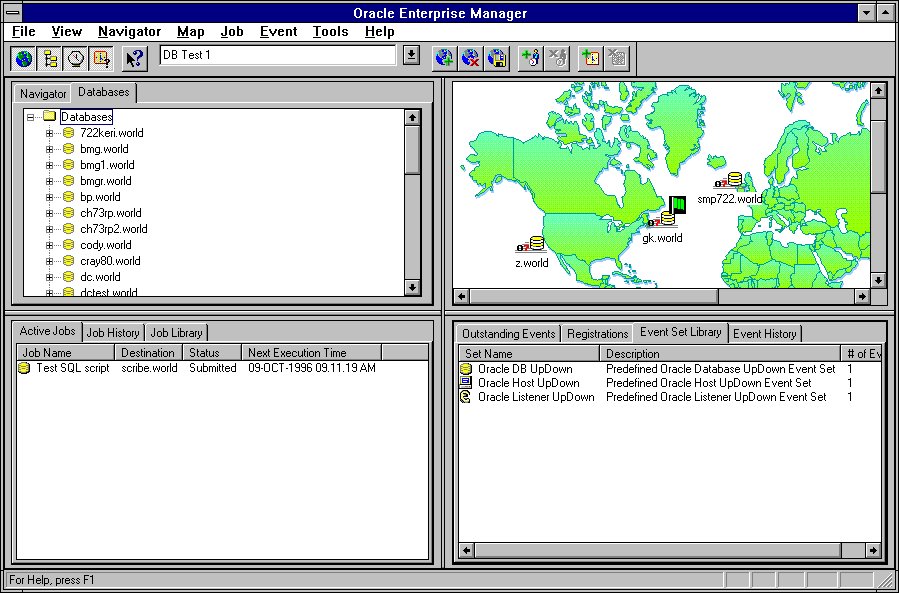| Oracle Enterprise Manager Concepts Guide | Library |
Product |
Contents |
Index |
| Oracle Enterprise Manager Concepts Guide | Library |
Product |
Contents |
Index |
The Console menus primarily manipulate objects in the Console windows. The toolbars provide graphic icons that represent most of the menu items. The Tools palette is primarily used to execute applications and utilities and contains graphic representations of the Tools menu items.
The menus, toolbars, and palettes are context-sensitive. You can also launch integrated applications from the Console: the menus options that are available depend on which Console window is currently active, and the tools available in the Tools palette depend on the type of service selected in the Navigator or Map windows.
Use the F1 help to determine which options are context-sensitive.

Figure 2-1: The Console Window
Navigator Window
The Navigator contains an object browser which provides a view of the network's nodes and services and the relationship between them. It simplifies basic user and group management tasks, enabling easy object manipulation through a tree list (a hierarchical view) of all objects in the system. Map Window
The Map window provides a customized, graphical representation of key objects created by an administrator to manage and monitor a subset or group of objects in the system. Objects can be grouped together based on any criteria, simplifying all operations performed on the group members. Job Scheduling Window
The Job Scheduling window is the user interface to the Job Scheduling System which enables you to automate repetitive tasks and provides the kind of "lights out" management which is vital in a large, distributed environment.
Event Management Window
In the Event Management window, you can create and register event sets, modify or cancel registrations, view the status of services being monitored, view summary information about events that have occurred, and further manage event information.
Using the Console
You can customize the Console to suit both your preferences and DBA tasks you perform. The individual windows in the Console can be minimized, resized, and relocated. The windows can be sized by selecting and dragging the splitter bar between the windows. Logging in
When you start Enterprise Manager, you are prompted for a username, password and service name. By supplying this authentication information, you log in to the Repository and are identified by the Console and its communication daemon. Performing Simple Single Tasks in the Navigator
The Navigator simplifies ad-hoc administration. For example, if you want to grant a privilege to a single user, you can click the right-mouse button on that user in the Navigator tree and choose Quick Edit from the context-sensitive menu. The Quick Edit User property sheet is displayed, allowing you to easily add the privilege. Customizing your View in the Navigator
Although the Navigator can be used to display all the objects being managed, you may not want to view the entire system in one Navigator tree if your system is a large and complex environment. Consequently, the Navigator can be divided into smaller tree lists. These subtrees can be displayed in separate windows. The objects in the Navigator can also be filtered so you can control which objects are displayed. Checking the Status of an Item
Graphical cues (status indicators) are used to show the state of an object in the Navigator tree. For example, the status of a database is depicted graphically by a green or red signal light icon. You can determine at a glance the states of items in the Navigator tree as they change dynamically. Creating User-Defined Groups
A user-defined group is a collection of nodes or services of the same type. You may want to group services based on organization, geographic location or function. For example, you might create a group of databases called CAL_MAIL that contains the mail databases in California. Creating Maps
You create maps by simply dragging and dropping objects from the Navigator into the Map window. Any number of maps can be created, then saved or edited. Using the Job Scheduling Window and Event Management Window
See Chapter 3, Job and Event Systems for more information on the Job Scheduling System and the Event Management System.
Integrating Applications into the Console
The Console application is written in Microsoft's Visual C++ and uses OLE2 technology to allow applications to integrate or plug in into the Console. Integrated applications also use the common services provided by the Enterprise Manager platform.
|
Prev Next |
Copyright © 1996 Oracle Corporation. All Rights Reserved. |
Library |
Product |
Contents |
Index |